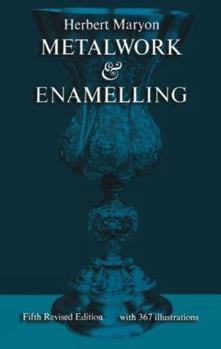Metalwork and Enamelling
Select Format
Select Condition 
Book Overview
All those concerned with goldsmithing, silversmithing, rare metal objects, or metal scientific instruments, or their repair or restoration will be delighted to find this bible of their craft available... This description may be from another edition of this product.
Format:Paperback
Language:English
ISBN:0486227022
ISBN13:9780486227023
Release Date:November 2011
Publisher:Dover Publications
Length:400 Pages
Weight:0.94 lbs.
Dimensions:0.8" x 5.4" x 8.4"
Customer Reviews
5 ratings
Add This Book to Your Library
Published by Thriftbooks.com User , 15 years ago
Any serious goldsmith will want to add this book to his/her library. The fact that Maryon died almost 50 years ago, and this book is still in active publication speaks for itself.
A classic of metalwork
Published by Thriftbooks.com User , 15 years ago
This title first appeared in 1912, nearly 100 years ago at this writing. Despite its age, this remains a useful and inspiring manual for today's jewelers and silversmiths. It covers a wide range of basic and not-so-basic decorative techniques, inclduing filigree, granulation, stone setting, chasing and repousse, etching, engraving, and enamelling. Silversmithing chapters address raising and sinking, among other techniques. A few sections describe tools that modern crafters have all but forgotten, such as a 'snarling iron' for shaping holloware too deep and narrow for other tools to handle. Although the editor of this fifth (1971) edition says that many tools and materials were updated, it still retains a lot of its older character. Soldering, for example, describes torches that I've only ever seen as antiques, and never mentions modern fuels like propane. Maryon presents dozens of formulas and recipes for everything from soldering alloys to etchants. While most are still helpful, many seem quaint. A few look downright scary to contemporary workers, such as a patination recipe that dissolves arsenic in acid. A little good sense will steer the modern reader toward safer techniques and materials, however. The section on twisted wire, for example, offers many decorative motifs that even beginners can use and explore on their own. Modern how-to books tend to be better illustrated and be more helpful regarding contemporary tools and materials. Also, some mis-statements (such as the idea that Japanese layered metals were bonded with solder) have been corrected by later research. Still, if you want to look back in time for inspiration, historical grounding, or wide-ranging coverage of many topics, this classic is a great place to start. -- wiredweird
the most stimulating text om metalwork
Published by Thriftbooks.com User , 18 years ago
For the professional, amateur or hobbyist, Herbert Maryon's book remains one of the most important books in its field. Originally published in 1912, this book was written at an important time in our history. It is a text of twentieth century knowledge and understanding encompassing over 3000 years of metalworking processes. It picks up where the master Italian goldsmith Benvenuto Cellini leaves off in his Treatises, and yet it is the last thorough publication that predates the advent of the modern electric power tool. The importance of this is multifold. First it brings every process down to the directness of basic hand tools. It is the jeweler making every mark and every cut through the simplicity of the basic tools that have been used for centuries. Processes are not obscured through expensive specialized equipment that are limited in their application. The same is true of the materials themselves. Sheet and wire that are readily made by the jeweler are the basis for all forms of fabrication. Hinges for example start with sheet metal and do not rely on the limitations of commercially produced products, thus freeing one financially and aesthetically.Thirdly, the use of basic hand tools expands the realm of the small studio. A simple burin, scraper and burnisher can accomplish many of the same tasks that match hundreds of dollars worth of specialized tools while performing a greater range of uses. Many of these tools can also be made by the jeweler or adapted to their own personal applications. Herbert Maryon was a master metalsmith himself. His expertise is evident throughout the book. While no one book can cover everything, this book provides a foundation to develop any number of approaches. His sample of seventy-two kinds of twisted wire is one example of taking a basic technique and turning it into a full scope of possibilities of the highest caliber. From fabrication to casting, stone setting to enamel this book provides a wealth of information and insight. (Review by Robert Jackson, University of Georgia, Athens, Georgia USA)
Keeping the rest of them honest.
Published by Thriftbooks.com User , 20 years ago
The first two reviews are dead on target. However,there is another aspect to Marion's book. It gives a fine perspective for judging newer texts and would-be teachers. During a novice's jewelry class, students were offered a chance to take an advanced course, given by one of the instructor's friends. It would show us a "special method" of soldering fine gold grain work. An excellent method is plainly laid out on pages ten and eleven of Metalwork & Enamelling. These two pages saved me over four hundred dollars; a nice return on the book's price.
Excellent book for the price.
Published by Thriftbooks.com User , 26 years ago
I have owned this book for 15 years and I think it is an excellent reference book for jewellers and metal smiths. It covers all types of metal work including gold and silversmithing, jewellery, stone setting and enamelling using traditional techniques. Written by Herbert Maryon O.B.E., who was one of London's best gold and silversmiths.





